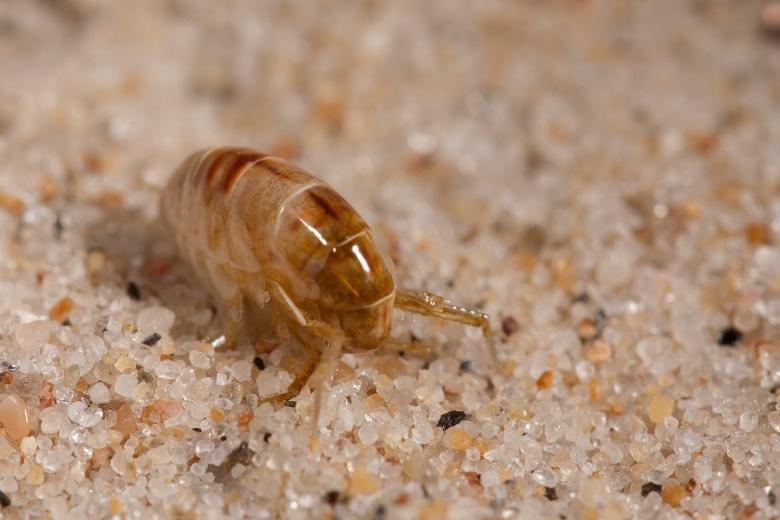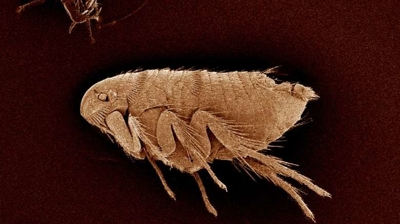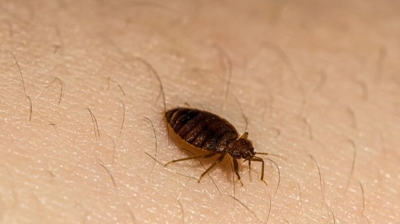
Sand Flea Control Services

Are Sand Fleas Harmful?
Sand fleas (Tunga penetrans) can be harmful in several ways, depending on the species and the environment. Sand fleas can pose real problems for humans, pets, and even livestock:
- Health Risks to Humans: The parasitic sand flea can burrow into the skin, particularly around the feet, toes, or under toenails. Once embedded, the female flea swells with eggs, causing painful sores, swelling, and secondary infections (tungiasis). Left untreated, tungiasis can lead to ulcers, tissue damage, and even gangrene.
- Allergic Reactions: Some individuals may experience more severe allergic responses to sand flea bites, including hives, blistering, or persistent dermatitis.
- Risks to Pets: Dogs and cats walking or lying in infested sand can pick up parasitic sand fleas, which may burrow into their skin or cause irritation from bites.
- Infections: Pets scratching at sand flea bites risk developing skin infections. In areas where Tunga penetrans is present, animals can suffer debilitating infestations, sometimes leading to lameness or deformity.
- Secondary Infections: Open sores from bites or burrowing fleas can become entry points for bacteria. In unhygienic or tropical environments, this increases the risk of serious secondary infections.
- Nuisance Factor: Even if the species present are not parasitic, sand fleas are still a nuisance. Their bites itch intensely, can ruin outdoor activities at beaches or coastal properties, and may discourage tourism or make properties near infested areas less appealing.
Learn more: Do Sand Fleas Bite?
Sand Flea Appearance
Sand fleas, specifically Tunga penetrans (also called chigoe fleas, jiggers, or jigger fleas), are tiny parasitic fleas that burrow into the skin of humans and animals. Here’s what they look like:
- Size: Extremely small—typically 1 mm before feeding and up to 1 cm when engorged after embedding in a host’s skin.
- Color: Light brown to reddish-brown. Once engorged in the skin, the flea may appear as a whitish or yellowish bump with a black central dot (the exposed rear end of the flea).
- Shape: Like other fleas, they have a small, rounded, flattened body adapted for jumping. However, when embedded, the female becomes swollen and spherical, resembling a small cyst beneath the skin.
- Legs: Six legs, with the hind pair large and adapted for jumping (though once embedded, mobility is lost).
- Head & Mouthparts: Equipped with piercing mouthparts for feeding on blood.
- In Skin: The visible sign is usually a painful, itchy lesion with a dark spot in the center, which is the flea’s abdomen tip protruding for breathing, mating, and egg-laying.
- Before Infestation: Barely visible to the naked eye—resembles a small speck of dirt or a typical flea.
- After Infestation: The female enlarges dramatically under the skin, forming a raised lesion. This makes them far more noticeable than when free-living.
Learn more: What Do Sand Fleas Look Like?
Where Are Sand Fleas Found?
Sand fleas (Tunga penetrans) are found mainly in tropical and subtropical regions, especially where people and animals live in close contact with sandy or dusty soil. Their distribution is strongly tied to warm climates, dry sandy environments, and poor sanitation:
- Africa: Widespread in sub-Saharan Africa (particularly East, West, and Central Africa).
- Latin America & the Caribbean: Found in rural and coastal areas of countries like Brazil, Colombia, Peru, and Haiti.
- Other regions: Historically reported in parts of India and tropical Asia, but far less common.
- Sandy soils: Common in dry, loose, and shaded sandy areas.
- Animal shelters & human dwellings: Thrive in places with dirt floors, cracks, and crevices.
- Coastal areas & beaches: Especially in communities where people walk barefoot on sandy ground.
- Around livestock: Pigs, dogs, cats, cattle, and rodents serve as reservoirs, helping maintain flea populations.
Risk Environments for Humans
- Walking barefoot in infested sand or soil.
- Living in homes with unpaved floors or without proper sanitation.
- Sleeping or resting on the ground in endemic areas.
Sand fleas (Tunga penetrans) are found in tropical, sandy, and dusty regions of Africa, the Caribbean, South America, and parts of Central America, where they infest humans and animals.
What Do Sand Fleas Eat?
Sand fleas (Tunga penetrans) are blood-feeding parasites, and their diet depends on whether they are free-living or embedded in a host.
- Adult Sand Fleas: Males and females feed on the blood of warm-blooded hosts (humans, dogs, pigs, cattle, and wildlife). Males bite and feed briefly, then leave the host. Females, however, burrow into the skin of the host, where they feed continuously on blood and tissue fluids. This bloodmeal fuels egg production.
- Larvae: Sand flea larvae do not feed on blood. Instead, they live in the soil or sand, where they consume organic debris, such as skin flakes, hair, fecal matter, and decaying plant material.
- Pupae: The pupal stage does not feed. The insect remains inside its cocoon while metamorphosis occurs.
Larvae eat organic debris in the soil. Adults (especially females) feed on blood and tissue fluids of warm-blooded hosts.
Sand Flea Life Cycle
The life cycle of the sand flea (Tunga penetrans) is unusual and medically important because it involves the female flea embedding in the skin of a host:
- Egg Stage: After a female burrows into the skin (often on the feet or under toenails), her abdomen enlarges as she feeds on blood. Over 1–2 weeks, she produces and expels hundreds of eggs (up to 200 per day). Eggs are released through the tiny opening in the skin where the flea’s rear end protrudes. The eggs fall to the ground, where they develop in soil, sand, or dust.
- Larval Stage: Eggs hatch within 1–6 days into tiny, wormlike larvae. The larvae live freely in the environment, feeding on organic debris and animal waste. They molt twice, passing through two larval stages over about 5–15 days.
- Pupal Stage: After the larval stage, they spin small cocoons in which they pupate. This stage typically lasts 7–14 days, though pupae can remain dormant longer if environmental conditions are poor.
- Adult Stage: Adult fleas emerge from cocoons and seek a warm-blooded host (humans, dogs, pigs, cattle, and other animals). Both sexes can jump and feed on blood, but only the female burrows permanently into the host’s skin. The male dies after mating and does not embed.
Once inside the skin, the female swells up (to nearly 1 cm) as she feeds and develops eggs. After 2–3 weeks, her eggs are expelled and she dies, remaining as a foreign body that often causes secondary infection if not removed. The cycle then restarts as the expelled eggs hatch in the environment.
Total Life Cycle Duration: About 3–4 weeks from egg to adult under favorable conditions.

Hear From Our Happy Customers
-
"Great Communication"
Tech was on time, communication was great, and he accommodated my needs.
- Alonzo W. -
"Wonderful Service"
Wonderful service. Jarvis is great. Took care of everything I needed. Thank you!
- Henry P. -
"Very Knowledgeable"
The tech that arrived was courteous, professional, and very knowledgeable. He was Great.
- Uerial I. -
"Exceeds Expectations"
I can’t say enough positive things about this company... The tech that came out, Jarvis went above and beyond my expectations. Thank you guys, I will continue using your services.
- Jake M. -
"Professional & Considerate"
I’m pleased with Miche services. Jarvis came today. Professional and considerate. Thank you!
- Judy B. -
"Fantastic & Patient"
Jarvis was fantastic and patient. He answered my questions with an in-depth explanation and addressed all of my areas of concern. Would love for him to be my assigned tech going forward. Well done!
- Yonnette M.



